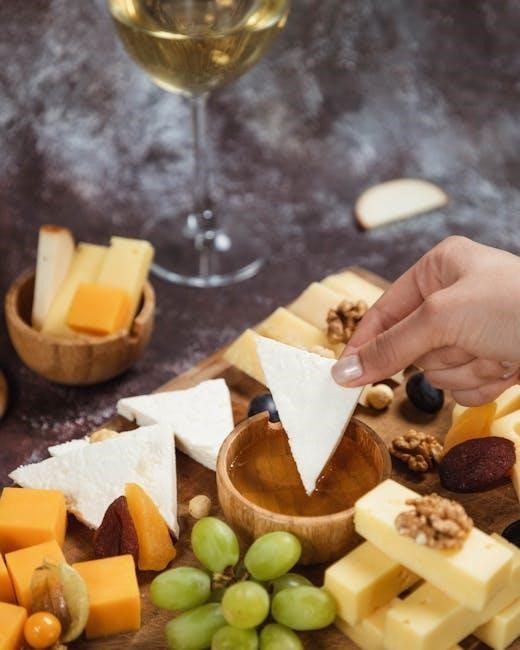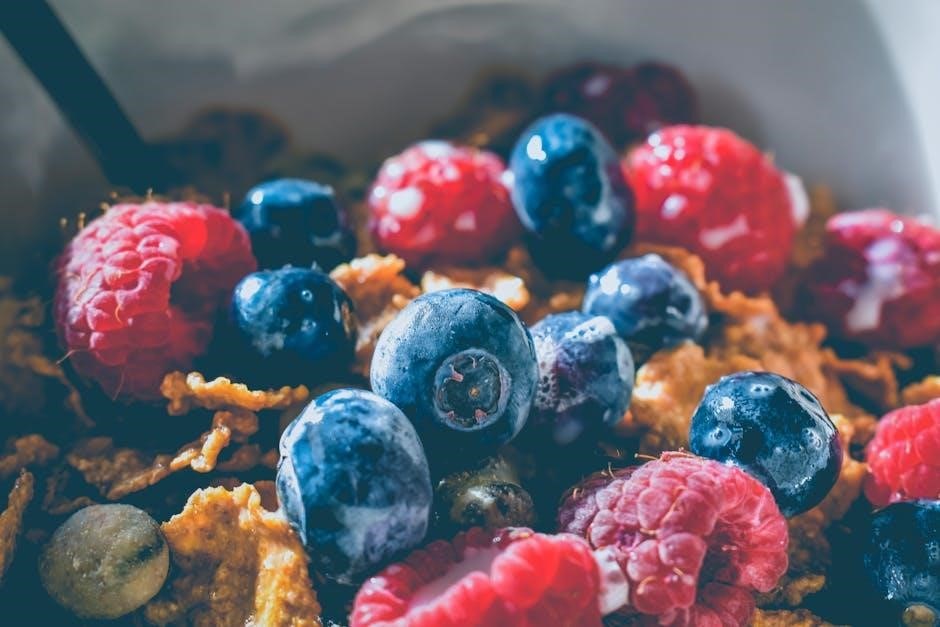
1.1. What Are Gluten and Dairy-Free Diets?
Gluten and dairy-free diets eliminate gluten (found in wheat, barley, and rye) and dairy products, offering a dietary approach for those with allergies, intolerances, or digestive issues.
Gluten and dairy-free diets are dietary plans that exclude foods containing gluten, a protein found in wheat, barley, and rye, and dairy products, which include milk and lactose-derived ingredients. These diets are often adopted by individuals with medical conditions such as celiac disease, lactose intolerance, or dairy allergies. They are also chosen by those who experience digestive discomfort or inflammation from consuming these foods. The primary goal is to eliminate potential irritants and promote better health outcomes. By focusing on naturally gluten-free and dairy-free alternatives, such as fruits, vegetables, lean meats, and plant-based milk, individuals can maintain a balanced and nutritious diet. This approach requires careful attention to food labels and ingredients to ensure compliance with dietary restrictions.
1.2. Benefits of a Gluten and Dairy-Free Lifestyle
Adopting a gluten and dairy-free lifestyle offers numerous health benefits, particularly for those with intolerances or allergies. Individuals often experience improved digestion, reduced bloating, and alleviated symptoms of conditions like celiac disease or lactose intolerance. Many report enhanced energy levels and reduced inflammation, which can contribute to overall well-being. This dietary approach encourages a focus on whole, nutrient-rich foods, promoting a more balanced diet. Additionally, avoiding gluten and dairy can help identify and eliminate potential triggers for digestive discomfort or skin issues. For some, this lifestyle may also support weight management and improve mental clarity. By eliminating irritants, the body can function more efficiently, leading to a healthier and more vibrant life. This approach is not just a diet but a long-term commitment to better health and vitality.
1.3. Who Might Benefit from a Gluten and Dairy-Free Diet?
A gluten and dairy-free diet is particularly beneficial for individuals with specific health conditions. Those diagnosed with celiac disease or non-celiac gluten sensitivity require a gluten-free diet to avoid severe digestive and autoimmune complications. Similarly, individuals with lactose intolerance or dairy allergies must eliminate dairy products to prevent symptoms like bloating, diarrhea, and skin rashes. Additionally, people with irritable bowel syndrome (IBS) or inflammatory bowel disease (IBD) may find relief by removing these common irritants. Others who might benefit include those with autoimmune conditions, such as rheumatoid arthritis, where reducing inflammation through diet can be advantageous. Even individuals without medical conditions but experiencing general digestive discomfort or fatigue may find improved well-being by adopting this dietary approach. It’s essential for anyone considering this lifestyle to consult a healthcare provider to ensure it meets their nutritional needs.
Gluten and Dairy-Free Food List Categories
Gluten and dairy-free diets are organized into categories like fruits, vegetables, meats, poultry, fish, seafood, grains, and dairy alternatives, ensuring a balanced and diverse nutritional intake.
2.1. Fruits and Vegetables
Fruits and vegetables are naturally gluten and dairy-free, making them a cornerstone of this diet. Fresh options like apples, bananas, spinach, and broccoli are ideal. Many frozen or canned varieties are also safe, as long as they don’t contain added gluten or dairy. Berries, citrus fruits, and leafy greens are rich in vitamins and antioxidants. Additionally, vegetables like sweet potatoes, carrots, and bell peppers provide essential nutrients. It’s important to check labels for any added ingredients, especially in processed or pre-packaged items. Incorporating a variety of colors ensures a broad range of nutrients, supporting overall health and well-being.
2.2. Meat and Poultry
Meat and poultry are naturally gluten and dairy-free, making them excellent choices for this diet. Fresh cuts of beef, chicken, turkey, and pork are ideal, as they contain no gluten or dairy. Wild game meats, such as venison or bison, are also suitable. When selecting processed meats like sausages or deli products, it’s crucial to check labels for hidden gluten or dairy ingredients. Opt for products labeled as gluten-free or made with clean, whole ingredients. Avoid breaded or marinated options, as they may contain gluten or dairy. Properly cooked meat and poultry provide essential protein and nutrients, making them a cornerstone of a balanced gluten and dairy-free lifestyle. Always ensure the sourcing and preparation align with dietary requirements to maintain safety and adherence to the diet.
2.3. Fish and Seafood
Fish and seafood are excellent additions to a gluten and dairy-free diet, offering rich sources of protein and essential nutrients. Fresh options like salmon, cod, tilapia, shrimp, and mussels are naturally free from gluten and dairy. Canned varieties, such as tuna or sardines, are also suitable, provided they are packed in water or olive oil without added gluten or dairy. Smoked or cured fish like salmon or trout can be included, but check for any added ingredients. Avoid breaded or battered seafood, as these typically contain gluten. When dining out, ensure seafood is not cross-contaminated with gluten or dairy during preparation. Properly prepared fish and seafood provide omega-3 fatty acids and other vital nutrients, supporting overall health and well-being in a gluten and dairy-free lifestyle. Always verify the sourcing and preparation methods to maintain adherence to dietary requirements.

Detailed Food List
A comprehensive guide to gluten and dairy-free foods, categorized for ease. Includes fruits, vegetables, lean proteins, whole grains, and snacks, ensuring diverse and nutritious dietary options.
3.1. Grains and Starches
For a gluten and dairy-free diet, grains and starches are essential for providing fiber, nutrients, and energy; Safe options include rice, quinoa, corn, millet, and sorghum. Certified gluten-free oats are also a great choice. Starches like tapioca, arrowroot, and potato starch are excellent for thickening sauces or baking. Many gluten-free breads, pastas, and cereals are made from these grains and are widely available. Always check labels for certification symbols to ensure they meet dietary requirements. These grains and starches offer versatility in meal planning and can be used in a variety of recipes, from savory dishes to baked goods. Incorporating a mix of whole grains and starches ensures a balanced and satisfying diet.
3.2. Dairy-Free Alternatives
Dairy-free alternatives provide a wide range of options for those avoiding traditional dairy products. Popular choices include almond milk, coconut milk, oat milk, and cashew milk, which are versatile for cooking, baking, and drinking. Dairy-free yogurt and cheese alternatives, made from ingredients like coconut oil, almond milk, and cashews, are also readily available. These products mimic the taste and texture of traditional dairy, making them ideal for recipes and snacks. Additionally, vegan butter and cream alternatives offer similar functionality in both sweet and savory dishes. When shopping, look for certification symbols like the “Dairy-Free” or “Vegan” label to ensure compliance with dietary restrictions. These alternatives are not only delicious but also cater to various culinary needs, making a dairy-free lifestyle accessible and enjoyable.
3.3. Snacks and Convenience Foods
Snacks and convenience foods play a crucial role in maintaining a gluten and dairy-free diet. Popular options include gluten-free crackers, chips, and energy bars made from ingredients like rice, corn, and quinoa. Feel Good Foods offers a variety of gluten-free and dairy-free snacks, such as egg rolls and potstickers, which are both convenient and flavorful; Mikey’s hot pockets are another great option, providing a quick meal solution. For those with dietary restrictions, nuts, seeds, and dried fruits are excellent choices for on-the-go snacking. Many brands now offer pre-packaged, certified gluten-free and dairy-free snacks, making it easier to find options that fit your lifestyle. These snacks are not only convenient but also cater to a wide range of tastes, ensuring that you never compromise on flavor while staying true to your dietary preferences.
Pantry Staples
Pantry staples for a gluten and dairy-free diet include gluten-free flours, baking supplies, and dairy-free milk alternatives. These essentials help maintain a versatile and sustainable dietary lifestyle.
4.1. Gluten-Free Flours and Baking Supplies
Gluten-free flours and baking supplies are essential for creating delicious and safe dishes. Popular options include almond flour, coconut flour, rice flour, and cassava flour, each offering unique textures and flavors. Baking supplies like gluten-free baking powder, xanthan gum, and starches (e.g., tapioca or potato) help replicate traditional baked goods. Many pre-mixed gluten-free flour blends are available, simplifying recipes. When shopping, look for certification symbols ensuring products are free from gluten and dairy. These staples allow for creative baking, from bread to desserts, while adhering to dietary restrictions. Always check labels to confirm ingredients meet your specific needs.
4.2. Dairy-Free Milk and Other Alternatives
Dairy-free milk alternatives are a cornerstone of a gluten and dairy-free diet, providing versatile options for cooking and consumption. Popular choices include almond milk, soy milk, coconut milk, oat milk, and cashew milk. These alternatives are naturally free from lactose and dairy proteins, making them ideal for those with intolerances or preferences. Many are fortified with calcium, vitamins, and minerals to mimic traditional milk’s nutritional profile. Additionally, dairy-free yogurts and cheeses made from coconut oil, nuts, or soy offer creamy textures without dairy. When selecting these products, ensure they are labeled as gluten-free to avoid cross-contamination. These alternatives allow individuals to enjoy smoothies, baking, and everyday meals while maintaining their dietary restrictions. Always check labels for added sugars and opt for unsweetened versions for healthier choices.

Eating Out on a Gluten and Dairy-Free Diet
Eating out requires careful planning to avoid gluten and dairy. Inform your server of dietary needs, ask for gluten-free options, and verify ingredients to ensure safety and compliance.
5.1. How to Navigate Restaurant Menus
Navigating restaurant menus while adhering to a gluten and dairy-free diet requires careful communication and awareness. Start by informing your server of your dietary restrictions to ensure they can guide you through safe options. Many restaurants now offer gluten-free menus or can modify dishes to accommodate your needs. Focus on naturally gluten and dairy-free options like grilled meats, fish, or salads, but always verify ingredients. Be cautious of hidden sources, such as gluten in sauces or dairy in dressings. Don’t hesitate to ask questions or request substitutions. If unsure, choose simple, unprocessed dishes to minimize risks. Some restaurants also provide allergen information or gluten-free certifications, which can help you make informed choices. Planning ahead by calling the restaurant or checking their menu online can also make dining out easier and more enjoyable.
5.2. Common Hidden Sources of Gluten and Dairy
Identifying hidden sources of gluten and dairy is crucial for maintaining a gluten and dairy-free diet, especially when dining out. Gluten can often be found in sauces, marinades, and processed ingredients like soy sauce, teriyaki, or certain seasonings. Dairy may lurk in unexpected places such as breaded foods, dressings, or sauces like Alfredo or hollandaise. Additionally, cross-contamination can occur in shared kitchen spaces, making it essential to communicate clearly with restaurant staff. Even seemingly safe options like salads or grilled meats can pose risks if topped with croutons or cheese. Always double-check ingredients and ask detailed questions to avoid accidental exposure. Being vigilant about these hidden sources ensures a safer and more enjoyable dining experience while adhering to your dietary restrictions. Awareness and proactive communication are key to navigating these potential pitfalls effectively.

Meal Planning and Recipes
Discover delicious gluten and dairy-free recipes, from hearty breakfasts to satisfying dinners. Explore creative meal ideas using ingredients like sunflower seeds, flax seeds, and gluten-free flours. Enjoy recipes for bread, snacks, and treats.
6.1. Breakfast Ideas
Starting your day with a gluten and dairy-free breakfast can be both nutritious and delicious. Consider options like smoothie bowls made with non-dairy milk, chia pudding, or gluten-free pancakes. For a hearty start, try muffins made with gluten-free flours or breakfast quinoa bowls loaded with fresh fruits and nuts. Even stuffed bell peppers with gluten-free grains can serve as a tasty morning meal. These ideas ensure a balanced and satisfying breakfast while adhering to dietary restrictions.
6.2. Lunch and Dinner Recipes
For satisfying gluten and dairy-free lunches and dinners, consider recipes like grilled fish with roasted vegetables or quinoa salads with fresh herbs. Stir-fries made with gluten-free soy sauce and served over rice or noodles are also excellent. Baked chicken with gluten-free seasonings or stuffed bell peppers with gluten-free grains offer hearty options. Salads featuring mixed greens, avocado, and olive oil-based dressings are refreshing and nutritious. Additionally, vegetable-based soups or stews can be prepared with gluten-free broth for a comforting meal. These recipes provide variety and ensure delicious, allergy-friendly dining experiences.
6.3. Desserts and Treats
Indulge in delicious gluten and dairy-free desserts like chocolate cake made with gluten-free flours and dairy-free chocolate. Fresh fruit crisps or salads with coconut cream offer light, refreshing options. Energy balls made from dates, nuts, and coconut oil are perfect snacks. Gluten-free sourdough bread can even be used to create decadent desserts. These treats cater to various dietary needs while maintaining flavor and satisfaction;

Understanding Food Labels
Recognizing hidden gluten and dairy sources on food labels is crucial for safe dietary choices. Certification symbols and clear ingredient lists help ensure compliance with gluten and dairy-free requirements.
7.1. Certification Symbols to Look For
When shopping for gluten and dairy-free products, look for trusted certification symbols like the Gluten-Free Certification Organization (GFCO) and the Celiac Support Association (CSA). These symbols ensure products meet strict standards. Additionally, labels such as “dairy-free” or “lactose-free” indicate the absence of dairy. Always check for cross-contamination statements, as they provide assurance that the product was processed in a facility free from gluten and dairy. These certifications are vital for maintaining a safe and compliant diet, especially for those with severe allergies or intolerances. By relying on these symbols, consumers can make informed choices and avoid potential health risks associated with hidden gluten or dairy ingredients.
7.2. How to Read Nutrition Labels
Reading nutrition labels is crucial for maintaining a gluten and dairy-free diet. Start by checking the ingredient list for allergens like wheat, barley, rye, milk, and lactose. Look for hidden sources of gluten, such as malt, brewer’s yeast, and hydrolyzed wheat protein. For dairy, be aware of terms like casein, whey, and lactose. Next, review the allergen statement, which is often highlighted at the end of the ingredient list. Ensure the product is labeled as “gluten-free” or “dairy-free.” Also, check the nutrition facts for any added sugars, sodium, or unhealthy fats. Be cautious of cross-contamination warnings, as they indicate the product was processed in a facility that handles gluten or dairy. Always prioritize products with certification symbols for added assurance. By carefully reading labels, you can make informed decisions and maintain a safe, compliant diet.
Health Benefits of a Gluten and Dairy-Free Diet
A gluten and dairy-free diet can improve digestion, reduce inflammation, and boost energy levels. It may also alleviate symptoms of conditions like celiac disease, lactose intolerance, and irritable bowel syndrome.
8.1. Improved Digestion
Adopting a gluten and dairy-free diet often leads to improved digestion, particularly for individuals with conditions like celiac disease or lactose intolerance. Gluten can cause inflammation in the small intestine, impairing nutrient absorption, while dairy contains lactose, which many people struggle to digest. Removing these triggers can reduce symptoms such as bloating, gas, and abdominal pain. Additionally, a diet free from gluten and dairy promotes a healthier gut microbiome, enhancing overall digestive function. Many individuals report fewer digestive issues and a reduction in irritable bowel syndrome (IBS) symptoms. This dietary change can also help alleviate inflammation in the digestive tract, fostering a more balanced and efficient digestive system. Improved digestion not only enhances comfort but also supports better nutrient absorption, leading to overall better health and well-being.
8.2. Reduced Inflammation
A gluten and dairy-free diet can significantly reduce inflammation in the body, particularly for individuals with autoimmune conditions or sensitivities. Gluten, a protein found in wheat, barley, and rye, can trigger an inflammatory response in the intestinal lining, leading to leaky gut syndrome and systemic inflammation. Similarly, dairy products contain proteins like casein, which can also provoke inflammatory reactions. By eliminating these triggers, the body experiences less irritation and inflammation, potentially alleviating symptoms associated with conditions like rheumatoid arthritis, celiac disease, and irritable bowel syndrome. Reduced inflammation can also contribute to improved skin health, joint function, and overall well-being. This dietary approach helps create a more balanced and less reactive immune system, promoting long-term health benefits.
8.3. Increased Energy Levels
Adopting a gluten and dairy-free diet can lead to increased energy levels for many individuals. By eliminating inflammatory triggers like gluten and dairy, the body experiences less digestive strain and reduced inflammation. This shift allows the body to allocate more energy to vital functions rather than recovery and repair. Many people report feeling more vibrant and less fatigued after transitioning to this diet, as it often improves nutrient absorption and reduces bloating. Additionally, focusing on whole, nutrient-dense foods like fruits, vegetables, lean proteins, and gluten-free grains provides sustained energy without the crashes associated with processed or high-sugar foods. Over time, this dietary change can enhance overall vitality, making it easier to maintain an active and energetic lifestyle.
Leave a Reply
You must be logged in to post a comment.